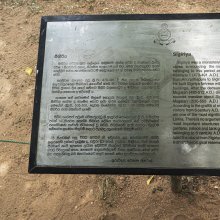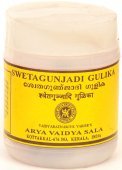Kanta, Kānta, Kaṇṭa, Kāntā, Kamta, Kānṭā: 32 definitions
Introduction:
Kanta means something in Buddhism, Pali, Hinduism, Sanskrit, Jainism, Prakrit, Marathi, Hindi, biology. If you want to know the exact meaning, history, etymology or English translation of this term then check out the descriptions on this page. Add your comment or reference to a book if you want to contribute to this summary article.
Images (photo gallery)
In Hinduism
Ayurveda (science of life)
Rasashastra (Alchemy and Herbo-Mineral preparations)
Source: Wisdom Library: Rasa-śāstra1) Kānta (कान्त) is one of the variations of Iron (Loha), according to the Rasaprakāśasudhākara: a 13th century Sanskrit book on Indian alchemy, or, Rasaśāstra. It is considered superior to the other variations of Iron named Tīkṣṇa and Muṇḍa.
Kānta can be further divided into four variations:
- Romaka (obtained from mines),
- Bhrāmaka (obtained from mountains),
- Cumbaka (obtained from Vindhya hills)
- and Drāvaka (obtained from Himālaya hills)
2) Kānta (कान्त) or Kāntarasa is the name of an Ayurvedic recipe defined in the fourth volume of the Rasajalanidhi (chapter 2, dealing with jvara: fever). These remedies are classified as Iatrochemistry and form part of the ancient Indian science known as Rasaśāstra (medical alchemy). Pārvatīśaṅkara is an ayurveda treatment and should be taken with caution and in accordance with rules laid down in the texts.
Accordingly, when using such recipes (e.g., kānta-rasa): “the minerals (uparasa), poisons (viṣa), and other drugs (except herbs), referred to as ingredients of medicines, are to be duly purified and incinerated, as the case may be, in accordance with the processes laid out in the texts.” (see introduction to Iatro chemical medicines)
Source: archive.org: Rasa-Jala-Nidhi: Or Ocean of indian chemistry and alchemyKānta (कान्त) refers to a variety of iron—an oxide of iron of which load stone is & variety (see the Rasajalanidhi by Bhudeb Mookerji volume 3)
Nighantu (Synonyms and Characteristics of Drugs and technical terms)
Source: WorldCat: Rāj nighaṇṭuKaṇṭa (कण्ट) is another name for Kṣudragokṣura, a medicinal plant related with Gokṣura (Tribulus terrestris Linn.), according to verse 4.40-43 of the 13th-century Raj Nighantu or Rājanighaṇṭu. Note: Gokṣura is of two kinds i.e. with smaller and bigger fruits. Both these species have more than three spikes. The fourth chapter (śatāhvādi-varga) of this book enumerates eighty varieties of small plants (pṛthu-kṣupa). Together with the names Kaṇṭa and Kṣudragokṣura, there are a total of sixteen Sanskrit synonyms identified for this plant.
Toxicology (Study and Treatment of poison)
Source: Shodhganga: Kasyapa Samhita—Text on Visha ChikitsaKaṇṭa (कण्ट) (or Kaṇṭaka) is the name of an ingredient used in the treatment of Rājilā-snake-bites, according to the Kāśyapa Saṃhitā: an ancient Sanskrit text from the Pāñcarātra tradition dealing with both Tantra and Viṣacikitsā—an important topic from Āyurveda which deals with the study of Toxicology (Viṣavidyā or Sarpavidyā).—The tenth Adhyāya prescribes antidotes for Rājilā snake venom.—According to the Kāśyapasaṃhitā verse X.29b-32: “[...] The sweat must be removed with water to which Piṇḍāra patrikā and Kaṇṭa (Kaṇṭaka) have been added. Āmalakī must be placed on the head during bath in the morning”.
Unclassified Ayurveda definitions
Source: Wisdom Library: Āyurveda and botanyKāntā (कान्ता) is a synonym for Priyaṅgu, which is a Sanskrit name for a medicinal plant (Callicarpa macrophylla). It is a technical term used throughout Ayurvedic literature such as the Caraka-saṃhitā and the Suśruta-saṃhitā. This synonym was identified by Amarasiṃha in his Amarakośa (a Sanskrit botanical thesaurus from the 4th century). It is also mentioned as a synonym in the Bhāvaprakāśa-nighaṇṭu (medicinal thesareus) authored by Bhāvamiśra 16th century.

Āyurveda (आयुर्वेद, ayurveda) is a branch of Indian science dealing with medicine, herbalism, taxology, anatomy, surgery, alchemy and related topics. Traditional practice of Āyurveda in ancient India dates back to at least the first millenium BC. Literature is commonly written in Sanskrit using various poetic metres.
Vastushastra (architecture)
Source: Wisdom Library: Vāstu-śāstraKānta (कान्त) refers to a type of temple (prāsāda) classified under the group named Kailāśa, according to Samarāṅgaṇasūtradhāra chapter 49. The Kailāśa group contains ten out of a sixty-four total prāsādas (temples) classified under five prime vimānas (aerial car/palace), which were created by Brahmā for as many gods (including himself). This group represents temples (e.g. Kānta) that are to be globular shaped. The prāsādas, or ‘temples’, represent the dwelling place of God and are to be built in towns. The Samarāṅgaṇasūtradhāra is an 11th-century encyclopedia dealing with various topics from the Vāstuśāstra.

Vastushastra (वास्तुशास्त्र, vāstuśāstra) refers to the ancient Indian science (shastra) of architecture (vastu), dealing with topics such architecture, sculpture, town-building, fort building and various other constructions. Vastu also deals with the philosophy of the architectural relation with the cosmic universe.
Purana and Itihasa (epic history)
Source: Cologne Digital Sanskrit Dictionaries: The Purana IndexKānta (कान्त).—One of the ten branches of the Sukarmaṇa group of devas.*
- * Brahmāṇḍa-purāṇa IV. 1. 88; Vāyu-purāṇa 100. 93.

The Purana (पुराण, purāṇas) refers to Sanskrit literature preserving ancient India’s vast cultural history, including historical legends, religious ceremonies, various arts and sciences. The eighteen mahapuranas total over 400,000 shlokas (metrical couplets) and date to at least several centuries BCE.
Natyashastra (theatrics and dramaturgy)
Source: Wisdom Library: Nāṭya-śāstra1a) Kāntā (कान्ता, “pleasing”) refers to a specific “glance” (dṛṣṭi), according to the Nāṭyaśāstra chapter 8. This is a type of glance that expresses the ‘erotic sentiment’ (śṛṅgārarasa). There are a total thirty-six glances defined.
(Description of Kāntā): When with a feeling of love a person contracts his eyebrows and castes a sidelong look, he is said to have a Kāntā (pleasing) Glance which has its origin in joy and pleasure. It is used in the Erotic Sentiment.
1b) Kāntā (कान्ता) is the name of a meter belonging to the Gāyatrī class of Dhruvā (songs) described in the Nāṭyaśāstra chapter 32:—“the metre which has in its feet of six syllables the first, the fourth, fifth and the sixth long, is kāntā”.
2) Kānta (कान्त, “beloved”) refers to a term to be used by women in love addressing their beloved during amorous union, according to the Nāṭyaśāstra chapter 24. Accordingly, “he in whose lips or other parts of the body no sign of amorous union with another woman is visible is called ‘beloved’ (kānta)”.
Source: Wisdom Library: SaṅgītaśiromaṇiKānta (कान्त, “lovely”) refers to one of the sixteen words that together make up the elā musical composition (prabandha), according to the Saṅgītaśiromaṇi 67-84. Elā is an important subgenre of song and was regarded as an auspicious and important prabandha (composition) in ancient Indian music (gāndharva). According to nirukta analysis, the etymological meaning of elā can be explained as follows: a represents Viṣṇu, i represents Kāmadeva, la represents Lakṣmī.
Kānta is one of the sixteen words of elā and has a presiding deity named rañjanī (the charming one) defined in the Saṅgītaśiromaṇi (“crest-jewel of music”), which is a 15th-century Sanskrit work on Indian musicology (gāndharvaśāstra).
Source: Google Books: Saṅgītaśiromaṇi: A Medieval Handbook of Indian MusicKānta (कान्त, “lovely”) refers to a musical expression corresponding with suśobhī (very brilliant), the tenth word of the elā composition (prabandha).—A sound is called lovely (kānta), when loveliness is accomplished in the three registers (sthāna).
Source: Shodhganga: Elements of Art and Architecture in the Trtiyakhanda of the Visnudharmottarapurana (natya)Kāntā (कान्ता) refers to one of the Thirty six kinds of Glances (dṛṣṭi) or “proper accomplishment of glances” (in Indian Dramas), according to the Viṣṇudharmottarapurāṇa, an ancient Sanskrit text which (being encyclopedic in nature) deals with a variety of cultural topics such as arts, architecture, music, grammar and astronomy.—Dṛṣṭi is very important in a dance form. The appropriate movements of eyes, eyeballs and eyebrows of an artist make the performance more charming. There are thirty six kinds of glances (dṛṣṭi) accepted in the Viṣṇudharmottarapurāṇa, for example kāntā, belonging to the rasadṛṣṭi division.

Natyashastra (नाट्यशास्त्र, nāṭyaśāstra) refers to both the ancient Indian tradition (shastra) of performing arts, (natya—theatrics, drama, dance, music), as well as the name of a Sanskrit work dealing with these subjects. It also teaches the rules for composing Dramatic plays (nataka), construction and performance of Theater, and Poetic works (kavya).
Chandas (prosody, study of Sanskrit metres)
Source: Shodhganga: a concise history of Sanskrit Chanda literatureKāntā (कान्ता) is the name of a Sanskrit metre (chandas) to which Hemacandra (1088-1173 C.E.) assigned the alternative name of Skhalita in his auto-commentary on the second chapter of the Chandonuśāsana. Hemacandra gives these alternative names for the metres by other authorities (like Bharata), even though the number of gaṇas or letters do not differ.

Chandas (छन्दस्) refers to Sanskrit prosody and represents one of the six Vedangas (auxiliary disciplines belonging to the study of the Vedas). The science of prosody (chandas-shastra) focusses on the study of the poetic meters such as the commonly known twenty-six metres mentioned by Pingalas.
Shaivism (Shaiva philosophy)
Source: Brill: Śaivism and the Tantric TraditionsKānta (कान्त) refers to “beautiful”, according to the 13th-century Matsyendrasaṃhitā: a Kubjikā-Tripurā oriented Tantric Yoga text of the Ṣaḍanvayaśāmbhava tradition from South India.—Accordingly, “[Visualisation of Parameśvara]:—[...] He is adorned with nice anklets, armlets, rings and bracelets, and he shines with small toe rings, channahīras, etc., and diadems and a crown. His face is gracious, beautiful (kānta), his lips are smeared with betel leaves. His mind is filled with the joy of wine, and his body is supreme bliss [itself]. [...]”.

Shaiva (शैव, śaiva) or Shaivism (śaivism) represents a tradition of Hinduism worshiping Shiva as the supreme being. Closely related to Shaktism, Shaiva literature includes a range of scriptures, including Tantras, while the root of this tradition may be traced back to the ancient Vedas.
In Buddhism
Tibetan Buddhism (Vajrayana or tantric Buddhism)
Source: academia.edu: The Structure and Meanings of the Heruka MaṇḍalaKāntā (कान्ता) is the name of a Ḍākinī who, together with the Vīra (hero) named Kānta forms one of the 36 pairs situated in the Jñānacakra, according to the 10th century Ḍākārṇava chapter 15. Accordingly, the jñānacakra refers to one of the three divisions of the saṃbhoga-puṭa (‘enjoyment layer’), situated in the Herukamaṇḍala. The 36 pairs of Ḍākinīs [viz., Kāntā] and Vīras are white in color; the shapes of their faces are in accordance with their names; they have four arms; they hold a skull bowl, a skull staff, a small drum, and a knife.

Tibetan Buddhism includes schools such as Nyingma, Kadampa, Kagyu and Gelug. Their primary canon of literature is divided in two broad categories: The Kangyur, which consists of Buddha’s words, and the Tengyur, which includes commentaries from various sources. Esotericism and tantra techniques (vajrayāna) are collected indepently.
In Jainism
General definition (in Jainism)
Source: archive.org: Een Kritische Studie Van Svayambhūdeva’s PaümacariuKānta (कान्त) participated in the war between Rāma and Rāvaṇa, on the side of the latter, as mentioned in Svayambhūdeva’s Paumacariu (Padmacarita, Paumacariya or Rāmāyaṇapurāṇa) chapter 57ff. Svayambhū or Svayambhūdeva (8th or 9th century) was a Jain householder who probably lived in Karnataka. His work recounts the popular Rāma story as known from the older work Rāmāyaṇa (written by Vālmīki). Various chapters [mentioning Kānta] are dedicated to the humongous battle whose armies (known as akṣauhiṇīs) consisted of millions of soldiers, horses and elephants, etc.

Jainism is an Indian religion of Dharma whose doctrine revolves around harmlessness (ahimsa) towards every living being. The two major branches (Digambara and Svetambara) of Jainism stimulate self-control (or, shramana, ‘self-reliance’) and spiritual development through a path of peace for the soul to progess to the ultimate goal.
Biology (plants and animals)
Source: Wisdom Library: Local Names of Plants and DrugsKanta [कान्ता] in the Hindi language is the name of a plant identified with Papaver guilelmi-waldemarii (Klotzsch) Christenh. & Byng from the Papaveraceae (Poppy) family having the following synonyms: Meconopsis aculeata, Meconopsis guilelmi-waldemarii, Meconopsis bikramii. For the possible medicinal usage of kanta, you can check this page for potential sources and references, although be aware that any some or none of the side-effects may not be mentioned here, wether they be harmful or beneficial to health.
Kanta [कान्ता] in the Sanskrit language is the name of a plant identified with Poranopsis paniculata (Roxb.) Roberty from the Convolvulaceae (Morning glory) family having the following synonyms: Porana paniculata.
Kanta in the Nepali language is the name of a plant identified with Cirsium wallichii DC. from the Asteraceae (Sunflower) family having the following synonyms: Cirsium nepalense, Cnicus wallichii.
Source: Google Books: CRC World Dictionary (Regional names)1) Kanta in India is the name of a plant defined with Aglaia odoratissima in various botanical sources. This page contains potential references in Ayurveda, modern medicine, and other folk traditions or local practices It has the synonym Aglaia diepenhorstii Miquel (among others).
2) Kanta is also identified with Amomum subulatum It has the synonym Cardamomum subulatum (Roxb.) Kuntze (etc.).
3) Kanta is also identified with Callicarpa macrophylla It has the synonym Callicarpa dunniana H. Lév. (etc.).
4) Kanta is also identified with Crocus sativus It has the synonym Safran officinarum Medik. (etc.).
5) Kanta is also identified with Ricinus communis It has the synonym Cataputia major Ludw. (etc.).
6) Kanta is also identified with Toona ciliata It has the synonym Cedrela microcarpa C. DC. (etc.).
Example references for further research on medicinal uses or toxicity (see latin names for full list):
· Kaiserliche Akademie der Wissenschaften in Wien. MathematischNaturwissenschaftliche Klasse. (1920)
· Flora Yunnanica (1977)
· Revisio Generum Plantarum (1891)
· Fragmenta Phytographiae Australiae (Mueller) (1858)
· Flore du Kouy-Tchéou (1915)
· Flore Analytique du Togo Phanérogames (1984)
If you are looking for specific details regarding Kanta, for example side effects, diet and recipes, chemical composition, pregnancy safety, health benefits, extract dosage, have a look at these references.

This sections includes definitions from the five kingdoms of living things: Animals, Plants, Fungi, Protists and Monera. It will include both the official binomial nomenclature (scientific names usually in Latin) as well as regional spellings and variants.
Languages of India and abroad
Pali-English dictionary
Source: BuddhaSasana: Concise Pali-English Dictionarykanta : (adj.) pleasant; lovely; agreeable. (m.), the beloved one; husband. (pp. of kamati), gone; entered into. || kantā (f.), a woman; the wife.
Source: Sutta: The Pali Text Society's Pali-English DictionaryKaṇṭa, (cp. next) a thorn Miln. 351. (Page 178)
— or —
1) Kanta, 2 (pp. of kantati2, Sk. kṛtta. kanta is analogyform. after pres. kantati, regularly we should expect katta. See also avakanta. It may be simply misreading for katta, cp. Kern, Toev. under parikanta. ) cut, cut out or off Th. 2, 223 (°salla=samucchinna-rāg’—ādisalla ThA. 179) cp. katta & pari°. (Page 185)
2) Kanta, 1 (Sk. kānta, pp. of kāmeti) — 1. (adj.) in special sense an attribute of worldly pleasure (cp. kāma, kāmaguṇā): pleasant, lovely, enjoyable; frequent in form. iṭṭhā kantā manāpā, referring to the pleasures of the senses S. I, 245; II, 192; IV, 60, 158, 235 sq.; V, 22, 60, 147; A. II, 66 sq.; M. I, 85; Sn. 759; It. 15; Vbh. 2, 100, 337; bāla° (lovely in the opinion of the ignorant) Sn. 399. ‹-› D. II, 265; III, 227 (ariya°); J. III, 264; V, 447; with ref. to the fruit of action as giving pleasure: °phala Kvu 35, 211, PvA. 277 (hatthi-) k° pleasing to elephants; of manta DhA. I, 163; of vīṇā J. VI, 255, 262; DhA. I, 163.—2. beloved by, favourite of, charming J. VI, 255, 262; DhA. I, 163.—3. (n.) the beloved one, the husband J. VI, 370 (wrongly written kan tena); of a precious stone Miln. 118; Sdhp. 608, cp. suriya°, canda°-kantā (f.) the beloved one, the wife J. V, 295; kantena (Instr.) agreeably, with kind words A. II, 213; J. V, 486 (where porisādassa kante should be read as porisādassak’ante).—a° undesired, disagreeable, unpleasant, in same form as kanta, e.g. D. II, 192; in other combination J. V, 295; Vbh. 100; Nett 180; PvA. 193.—akantena with unpleasant words A. II, 213.—kantatara compar. J. III, 260.

Pali is the language of the Tipiṭaka, which is the sacred canon of Theravāda Buddhism and contains much of the Buddha’s speech. Closeley related to Sanskrit, both languages are used interchangeably between religions.
Marathi-English dictionary
Source: DDSA: The Molesworth Marathi and English Dictionarykāṇṭa (कांट).—n A leech-like creature appearing in the rains. 2 f C A phāṭā or single stick of a mass of loppings (as of the bābhaḷa, bōra, mōgalī ēraṇḍa, śēra, kaṇhērī &c.) to form kumpaṇa or hedge.
--- OR ---
kāṇṭā (कांटा) [or काटा, kāṭā].—m (kaṇṭaka S) A thorn. 2 fig. A troublesome fellow, a pest, plague, bore, a prick in the side. 3 The tongue of a balance. 4 A balance having a tongue, esp. the balance of a shroff or goldsmith. 5 pl Erection of the hairs of the body (from fright, cold &c.), horripilation. 6 pl Eruptions or roughnesses remaining after fever. 7 pl Shivering preceding fever, rigors. 8 The sting of a scorpion. 9 The tongue or bolt (of a lock, padlock, spring, or catch), the portion which shoots out and retires. 10 The efflorescence (of the bamboo and some other plants). 11 The back-bone. 12 The cross drawn when a multiplication is to be proved. kāṇṭā karaṇēṃ To prove by this cross. 13 A disease in the throat incidental to parrots, starlings &c. 14 A quantity deducted or given on certain articles sold by weight. See under kaḍatā. 15 A rock in the sea or a river. 16 This term is applied generally to any thing resembling a thorn--to a fish bone, the rowel of a spur, the hand of a watch, the spikes or points of a rough bit, a saw &c., to a fork or prong, to bristles or stiff hairs on animals or vegetables &c. &c. 17 The congelations or crystals (of halavā or other candy). v yē, umaṭa, vaṭa, uṭha. kāṇṭā upaṭaṇēṃ g. of s. To lose one's thorn, i. e. one's troubler or trouble, one's tormentor or plague. kāṇṭā upaṭaṇēṃ g. of o. (as of a troubler &c. or of a malady.) To pluck up the very root or deepest spring of. kāṇṭā karaṇēṃ g. of o. To (esteem as a thorn and) withdraw from the company of. kāṇṭyācā nāyaṭā hōṇēṃ. (Ringworm arising from a thorn-puncture.) Expresses the rising of a great evil out of a small one. kāṇṭyānēṃ kāṇṭā kāḍhaṇēṃ To employ one hateful person or thing to destroy another.
--- OR ---
kānta (कांत).—f (kānti S) Lustre, gloss, glitter, brilliancy. 2 fig. Freshness, clearness, healthiness (of complexion or look). 3 fig. (Because of its glistening.) The exuvies or slough of a snake.
--- OR ---
kānta (कांत).—m (kātaṇa) Shavings of wood, ivory &c., under the turning lathe. 2 C (Corr. from kāṇṭha) Edge, verge, brink.
--- OR ---
kānta (कांत).—m (S) A husband. Abridged from lōha- kānta) The loadstone: also a calx prepared from it. Boilers &c. are made of it.
--- OR ---
kāntā (कांता).—f (S) A beloved or lovely woman, a mistress.
Source: DDSA: The Aryabhusan school dictionary, Marathi-Englishkāṇṭā (कांटा).—m A thorn. Balance. A pest. Erection of the hair of the body. The tongue (of a lock). The back-bone The hand of a watch. Congelations or crystals. kāṇṭā upaṭaṇēṃ Pluck up the very root of–any mischief or mischievous person. kāṇṭyācā nāyaṭā hōṇēṃ The rising of a great evil from a small one.
--- OR ---
kānta (कांत).—m A husband. f Lustre, gloss, glit ter. Shavings of wood, ivory &c. under the turning lathe. Freshness. See kānti.
--- OR ---
kāntā (कांता).—f A beloved or lovely woman. A mistress.
Marathi is an Indo-European language having over 70 million native speakers people in (predominantly) Maharashtra India. Marathi, like many other Indo-Aryan languages, evolved from early forms of Prakrit, which itself is a subset of Sanskrit, one of the most ancient languages of the world.
Sanskrit dictionary
Source: DDSA: The practical Sanskrit-English dictionaryKaṇṭa (कण्ट).—a. Thorny.
--- OR ---
Kanta (कन्त).—a. Happy.
--- OR ---
Kānta (कान्त).—p. p. [kam-kta]
1) Desired, favourite, loved, dear; कान्तं क्रतुं चाक्षुषम् (kāntaṃ kratuṃ cākṣuṣam) M.1.4.
2) Pleasing, agreeable; भीमकान्तैर्नृपगुणैः (bhīmakāntairnṛpaguṇaiḥ) R.1.16.
3) Lovely, beautiful; सर्वः कान्तमात्मीयं पश्यति (sarvaḥ kāntamātmīyaṃ paśyati) Ś.2.
-taḥ 1 A lover.
2) A husband; कान्तोदन्तः सुहृदुपगतः संगमात् किंचिदूनः (kāntodantaḥ suhṛdupagataḥ saṃgamāt kiṃcidūnaḥ) Meghadūta 12; Śiśupālavadha 1.3, 29.
3) Any beloved person.
4) The moon.
5) The spring.
6) A kind of iron.
7) A precious stone (in comp. with sūrya, candra and ayas).
8) An epithet of (1) Kārttikeya, (2) Kṛṣṇa.
-tam 1 Saffron.
2) A kind of iron.
--- OR ---
Kāntā (कान्ता).—
1) A beloved or lovely woman.
2) A mistress, wife in general; कान्तासखस्य शयनीयशिलातलं ते (kāntāsakhasya śayanīyaśilātalaṃ te) Uttararāmacarita 3.21; Śiśupālavadha 1.73.
3) The Priyaṅgu creeper.
4) Large cardamoms.
5) A kind of perfume.
6) The earth.
Source: Cologne Digital Sanskrit Dictionaries: Shabda-Sagara Sanskrit-English DictionaryKanta (कन्त).—mfn.
(-ntaḥ-ntā-ntaṃ) Happy. E. kaṃ and ta aff.
--- OR ---
Kānta (कान्त).—mfn.
(-ntaḥ-ntā-ntaṃ) 1. Pleasing, agreeable. 2. Lovely, beautiful. 3. Dear, beloved. m.
(-ntaḥ) 1. A name of Krishna. 2. The moon. 3. A husband. 4. Spring. 5. A precious stone; in which case it is compounded with sūrya, candra or ayas, as sūryakānta a crystal lens, &c. f.
(-ntā) 1. A wife, a mistress, any beloved or lovely woman. 2. A plant, commonly Priyangu: see priyaṅgu. 3. A grass, (Cyperus pertenuis.) n.
(-ntaṃ) 1. Iron. 2. Saffron. E. kam to desire, affix kta.
Source: Cologne Digital Sanskrit Dictionaries: Cappeller Sanskrit-English DictionaryKānta (कान्त).—[adjective] desired, loved, lovely, beautiful. [masculine] the beloved man, husband; [feminine] beloved or lovely woman, mistress, wife.
Source: Cologne Digital Sanskrit Dictionaries: Monier-Williams Sanskrit-English Dictionary1) Kaṇṭa (कण्ट):—m. (thought by some to be for original karnta, [from] √2. kṛt) a thorn, [Bhāgavata-purāṇa ix, 3, 7] (cf. tri-kaṇṭa, bahu-kaṇṭa, etc.)
2) the boundary of a village, [cf. Lexicographers, esp. such as amarasiṃha, halāyudha, hemacandra, etc.]
3) (cf. [Greek] κεντέω κεστός κέστρον ?)
4) Kanta (कन्त):—a mfn. ([from] 1. kam ind.), happy, [Pāṇini 5-2, 138.]
5) [from kam] b mfn. idem, [Tārānātha tarkavācaspati’s Vācaspatyam, Sanskrit dictionary]
6) Kānta (कान्त):—[from kam] a etc. See sub voce
7) 1. kānta mf(ā)n. ([from] √2. kam), desired, loved, dear, pleasing, agreeable, lovely, beautiful
8) m. any one beloved, a lover, husband
9) the moon, [cf. Lexicographers, esp. such as amarasiṃha, halāyudha, hemacandra, etc.]
10) the spring, [cf. Lexicographers, esp. such as amarasiṃha, halāyudha, hemacandra, etc.]
11) the plant Barringtonia Acutangula, [cf. Lexicographers, esp. such as amarasiṃha, halāyudha, hemacandra, etc.]
12) iron, [cf. Lexicographers, esp. such as amarasiṃha, halāyudha, hemacandra, etc.]
13) a stone (cf. sūrya-k, etc.), [cf. Lexicographers, esp. such as amarasiṃha, halāyudha, hemacandra, etc.]
14) Name of Kṛṣṇa, [cf. Lexicographers, esp. such as amarasiṃha, halāyudha, hemacandra, etc.]
15) of Skanda, [Mahābhārata iii, 14631]
16) of a son of Dharma-netra, [Harivaṃśa i, 33, 3]
17) Kāntā (कान्ता):—[from kānta] a f. a beloved or lovely woman, wife, mistress, [Kathāsaritsāgara]
18) [v.s. ...] a charming wife, [cf. Lexicographers, esp. such as amarasiṃha, halāyudha, hemacandra, etc.]
19) [v.s. ...] the earth, [cf. Lexicographers, esp. such as amarasiṃha, halāyudha, hemacandra, etc.]
20) [v.s. ...] Name of certain plants, [cf. Lexicographers, esp. such as amarasiṃha, halāyudha, hemacandra, etc.]
21) [v.s. ...] large cardamoms, [cf. Lexicographers, esp. such as amarasiṃha, halāyudha, hemacandra, etc.]
22) [v.s. ...] a kind of perfume (reṇukā, Piper aurantiacum), [cf. Lexicographers, esp. such as amarasiṃha, halāyudha, hemacandra, etc.]
23) [v.s. ...] Name of a metre of four lines of seventeen syllables each
24) [v.s. ...] a kind of Śruti
25) Kānta (कान्त):—n. saffron, [cf. Lexicographers, esp. such as amarasiṃha, halāyudha, hemacandra, etc.]
26) a kind of iron, [cf. Lexicographers, esp. such as amarasiṃha, halāyudha, hemacandra, etc.]
27) a magnet, [Buddhist literature]
28) a kind of house, [cf. Lexicographers, esp. such as amarasiṃha, halāyudha, hemacandra, etc.]
29) Kāntā (कान्ता):—[from kānta] b f. of kānta q.v.
Source: Cologne Digital Sanskrit Dictionaries: Yates Sanskrit-English Dictionary1) Kanta (कन्त):—[(ntaḥ-ntā-ntaṃ) a.] Happy.
2) Kānta (कान्त):—[(ntaḥ-ntā-ntaṃ) a.] Pleasing; lovely; beloved. m. Krishna; the moon; a husband; spring; a gem. f. A wife, a mistress; a plant.
Source: DDSA: Paia-sadda-mahannavo; a comprehensive Prakrit Hindi dictionary (S)Kānta (कान्त) in the Sanskrit language is related to the Prakrit words: Kaṃta, Kaṃtā.
[Sanskrit to German]
Sanskrit, also spelled संस्कृतम् (saṃskṛtam), is an ancient language of India commonly seen as the grandmother of the Indo-European language family (even English!). Closely allied with Prakrit and Pali, Sanskrit is more exhaustive in both grammar and terms and has the most extensive collection of literature in the world, greatly surpassing its sister-languages Greek and Latin.
Hindi dictionary
Source: DDSA: A practical Hindi-English dictionaryKanta in Hindi refers in English to:—(nf) wife; sweetheart; (a) beloved; lovely; —[sammita upadesha] a curtain lecture..—kanta (कांता) is alternatively transliterated as Kāṃtā.
...
Prakrit-English dictionary
Source: DDSA: Paia-sadda-mahannavo; a comprehensive Prakrit Hindi dictionary1) Kaṃta (कंत) in the Prakrit language is related to the Sanskrit word: Kṛt.
2) Kaṃta (कंत) also relates to the Sanskrit word: Kānta.
3) Kaṃta (कंत) also relates to the Sanskrit word: Krānta.
4) Kaṃtā (कंता) also relates to the Sanskrit word: Kāntā.
Prakrit is an ancient language closely associated with both Pali and Sanskrit. Jain literature is often composed in this language or sub-dialects, such as the Agamas and their commentaries which are written in Ardhamagadhi and Maharashtri Prakrit. The earliest extant texts can be dated to as early as the 4th century BCE although core portions might be older.
Kannada-English dictionary
Source: Alar: Kannada-English corpusKaṃṭa (ಕಂಟ):—
1) [noun] an ancient writing implement, a small metal rod with a pointed end for scratching letters on palm leaves; the Indian style.
2) [noun] that portion of a vessel above its neck.
--- OR ---
Kaṃṭa (ಕಂಟ):—[noun] (a corrupt form of karaṭa ) the hard outer case of a coconut-kernel; coconut shell.
--- OR ---
Kaṃṭa (ಕಂಟ):—[noun] a male cat; a tom-cat.
--- OR ---
Kaṃta (ಕಂತ):—
1) [noun] (dial.) a surface having gradual slope; downward gradient.
2) [noun] (dial.) a deep place or any of the deepest parts, as in water or earth.
3) [noun] (dial.) steep descent.
--- OR ---
Kāṃta (ಕಾಂತ):—[noun] the state or condition or fact of a word ending with 'ಕ'.
--- OR ---
Kāṃta (ಕಾಂತ):—
1) [adjective] desired; longed; craved; loved.
2) [adjective] attracting; charming; beautiful.
--- OR ---
Kāṃta (ಕಾಂತ):—
1) [noun] a man with reference to a woman to whom he is married; a husband.
2) [noun] a man who is loved by or who loves, a woman; a lover.
3) [noun] (in comp.) a stone.
4) [noun] the normal place of dwelling; a house.
5) [noun] the moon.
6) [noun] iron.
7) [noun] Křṣṇa.
8) [noun] Skanda (Subrahmaṇya).
9) [noun] any piece of certain kinds of material that has the property of attracting iron; a magnet.
10) [noun] (rhet.) the style that is pleasant, lucid, vivid and very attractive considered as the merits in poetics.
Kannada is a Dravidian language (as opposed to the Indo-European language family) mainly spoken in the southwestern region of India.
See also (Relevant definitions)
Starts with (+490): Kaantachamcha, Kaantawal, Kamtaamta, Kamtabalamapaka, Kamtabhikshe, Kamtacodane, Kamtadarshi, Kamtadhruva, Kamtadhruvasuci, Kamtadivataka, Kamtaga, Kamtagola, Kamtaguna, Kamtaia, Kamtaijjamta, Kamtaila, Kamtailla, Kamtajala, Kamtajavabu, Kamtakabhupa.
Ends with (+313): Abbhatikkanta, Abhikkanta, Abjakanta, Abjinikamta, Acakanta, Acirapakkanta, Adityakanta, Ahikanta, Aikanta, Akanta, Akanta Lokanta, Akar-kanta, Akarkanta, Akkanta, Alakanta, Alokkamta, Amarakanta, Ambakamta, Ambujakanta, Amshukanta.
Full-text (+650): Kantanghridohada, Kantayasa, Kantaphala, Shrikanta, Kantatva, Mahakanta, Nadikanta, Kantanuvritta, Bhogikanta, Kantalauha, Radhakanta, Padminikanta, Kantapuri, Kantampiti, Kantapatra, Kantamuttan, Varahakanta, Shrikantakatha, Lohakanta, Candrakanta.
Relevant text
Search found 81 books and stories containing Kanta, Kānta, Kaṇṭa, Kāntā, Kāṇṭa, Kāṇṭā, Kamta, Kaṃṭa, Kaṃta, Kaṃtā, Kantā, Kandrike, Kaṇḍrike, Kāṃta, Kānṭā, Kaanta; (plurals include: Kantas, Kāntas, Kaṇṭas, Kāntās, Kāṇṭas, Kāṇṭās, Kamtas, Kaṃṭas, Kaṃtas, Kaṃtās, Kantās, Kandrikes, Kaṇḍrikes, Kāṃtas, Kānṭās, Kaantas). You can also click to the full overview containing English textual excerpts. Below are direct links for the most relevant articles:
Bhajana-Rahasya (by Srila Bhaktivinoda Thakura Mahasaya)
Text 19 < [Chapter 6 - Ṣaṣṭha-yāma-sādhana (Sāyaṃ-kālīya-bhajana–bhāva)]
Text 14 < [Chapter 8 - Aṣṭama-yāma-sādhana (Rātri-līlā–prema-bhajana sambhoga)]
Text 26 < [Chapter 6 - Ṣaṣṭha-yāma-sādhana (Sāyaṃ-kālīya-bhajana–bhāva)]
Sahitya-kaumudi by Baladeva Vidyabhushana (by Gaurapada Dāsa)
Text 7.28 < [Chapter 7 - Literary Faults]
Text 9.50 < [Chapter 9 - Ornaments of Sound]
Text 4.14 < [Chapter 4 - First-rate Poetry]
Garga Samhita (English) (by Danavir Goswami)
Verse 1.15.28 < [Chapter 15 - Revelation of the Universal Form to Nanda’s Wife]
Verse 2.10.10 < [Chapter 10 - Description of Śrī Kṛṣṇa’s Herding the Cows]
Verse 3.5.10 < [Chapter 5 - The Dispute Among the Gopas]
Yogadrstisamuccaya of Haribhadra Suri (Study) (by Riddhi J. Shah)
Chapter 4.6a - The Sixth: Kāntādṛṣṭi (kāntā-dṛṣṭi)—Introduction < [Chapter 4 - The Eight Yogadṛṣṭis and the nature of a Liberated Soul]
Chapter 4.6b - Mīmāṃsā (cogitation—an outcome right knowledge) < [Chapter 4 - The Eight Yogadṛṣṭis and the nature of a Liberated Soul]
Chapter 3.5 - Introduction and Brief Account of the Eight Yogadṛṣṭis < [Chapter 3 - Introduction to the Yogadṛṣṭisamuccaya]
Satirical works of Kshemendra (study) (by Arpana Devi)
5.20. The Wife of the Old Man (vṛddhabhāryā) < [Chapter 5 - Kṣemendra’s objectives of Satire]
1.1. Upamā (simile) < [Chapter 4 - Literary study of the Three Satirical Works]
5.16. The Bawd (kuṭṭanī) < [Chapter 5 - Kṣemendra’s objectives of Satire]
Related products
(+1 more products available)








